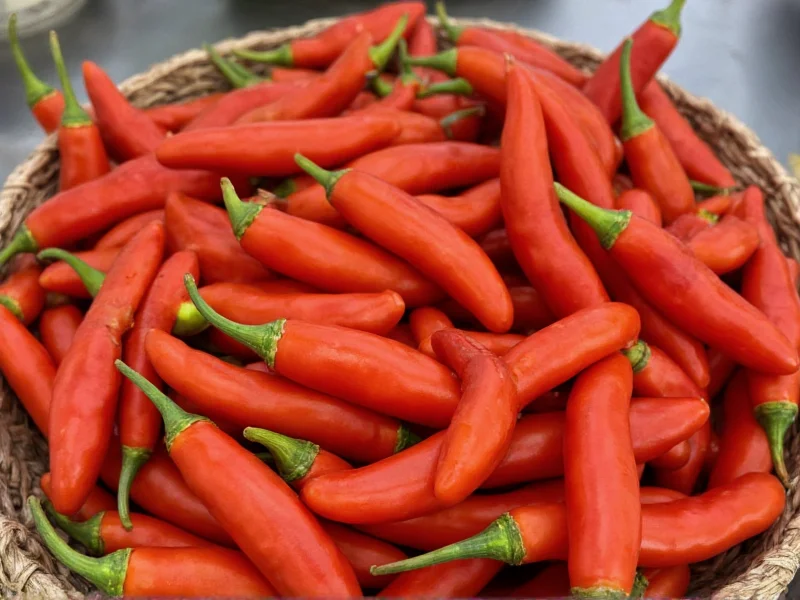Serrano chiles offer a distinctive visual profile that sets them apart from other common chili peppers. Understanding their appearance helps home cooks, gardeners, and shoppers identify them accurately in markets or gardens. These peppers belong to the Capsicum annuum species and share characteristics with other hot peppers while maintaining unique identifying features.
Physical Characteristics of Serrano Chiles
Serrano peppers display several key visual traits that make them recognizable:
Size and Shape
Serrano chiles typically measure between 1-4 inches (2.5-10 cm) in length and approximately 0.5 inches (1.3 cm) in diameter. Their shape is consistently slender and elongated with a pronounced taper from the shoulder to the pointed tip. The body often features a slight curve, though some varieties grow straighter. This slender profile distinguishes them from the thicker, blockier shape of jalapeños.
Color Progression
These peppers undergo a predictable color transformation as they mature:
| Maturity Stage | Color | Common Usage |
|---|---|---|
| Immature | Bright green | Fresh salsas, pickling |
| Mid-maturity | Dark green to olive | Cooking, roasting |
| Mature | Red, orange, or yellow | Drying, sauces, decorative |
The most common variety transitions from bright green to deep red, though some cultivars ripen to vibrant orange or golden yellow. The color change occurs gradually, with peppers often displaying intermediate shades during the ripening process.
Surface Texture and Structure
Serrano peppers feature a smooth, taut, and glossy skin surface without significant wrinkles. Their walls maintain consistent thinness (approximately 1/8 inch or 3 mm) along the entire length, contributing to their crisp texture when raw. The stem attachment is small but sturdy, with a characteristic five-pointed calyx (the green cap at the top). Unlike some larger peppers, serranos don't develop thick shoulders or noticeable bulges.
How Serrano Chiles Compare to Similar Peppers
Understanding the visual differences between serranos and other common chili peppers prevents confusion in the kitchen or garden:
Serrano vs. Jalapeño: Key Visual Differences
Many people confuse serranos with jalapeños, but several visual cues distinguish them:
- Size: Serranos are generally smaller (1-4 inches) compared to jalapeños (2-4 inches)
- Shape: Serranos maintain a consistent slender profile with a pronounced taper, while jalapeños have thicker shoulders and a more cylindrical shape
- Wall thickness: Serranos have uniformly thin walls, whereas jalapeños develop thicker walls, especially near the stem
- Color: Both start green and ripen red, but serranos often display brighter, more vibrant colors at each stage
- Surface: Serranos typically have smoother skin, while jalapeños frequently develop characteristic "corking" (light-colored stretch marks)
Serrano vs. Other Chili Peppers
Compared to other common varieties:
- Habanero: Much smaller and less rounded than the lantern-shaped habanero
- Cayenne: Shorter and thicker than the extremely slender cayenne pepper
- Fresno: Similar in size but with thicker walls and a more conical shape than serranos
- Thai chili: Serranos are larger and less slender than the pencil-thin Thai chilies
Identifying Quality Serrano Peppers
When selecting serrano chiles, look for these visual indicators of freshness and quality:
- Firmness: High-quality serranos feel rigid and snap crisply when bent
- Color: Vibrant, uniform color without dull patches or excessive blemishes
- Surface: Smooth, taut skin without wrinkles, soft spots, or shriveling
- Stem: Fresh, green stem attachment without browning or drying
- Weight: Feels substantial for its size, indicating proper hydration
Mature red serranos often develop a slightly glossy sheen compared to their green counterparts. Avoid peppers with soft spots, wrinkles, or discoloration, which indicate age or improper storage. The best serranos feel heavy for their size with crisp, vibrant coloring throughout.
Practical Applications of Serrano Appearance Knowledge
Recognizing serrano chiles by sight serves several practical purposes:
- Culinary substitution: Knowing visual differences helps when substituting between pepper varieties
- Gardening: Identifying proper maturity stages for harvesting
- Shopping: Selecting the freshest peppers at markets or grocery stores
- Recipe accuracy: Ensuring correct pepper type for authentic flavor profiles
- Safety: Distinguishing between similar-looking but significantly hotter varieties
The visual characteristics of serrano peppers directly correlate with their heat level and flavor profile. Green serranos typically offer bright, grassy notes with intense heat, while red varieties develop slightly sweeter, more complex flavors while maintaining their signature spiciness. Understanding these visual indicators helps cooks select the right pepper for their intended dish.











 浙公网安备
33010002000092号
浙公网安备
33010002000092号 浙B2-20120091-4
浙B2-20120091-4